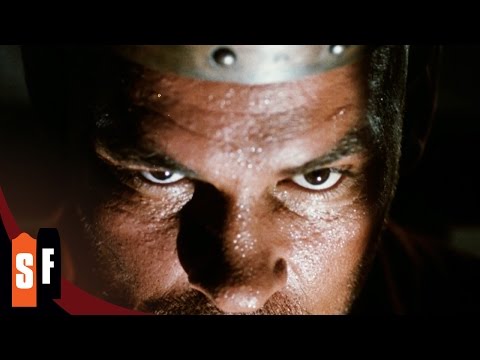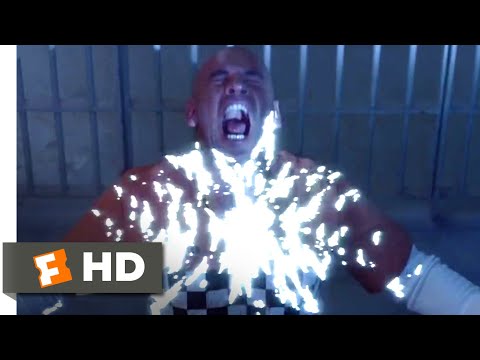Wes Craven’s “Shocker” (1989) opens with a strong case of déjà vu.
We see the close-up of crud-smudged hands putting something together in a workshop, while a bloody knife sits unattended to the side. It looks so much like the opener of Craven’s “A Nightmare on Elm St” (1984) that only the slick cinematography and busy heavy metal soundtrack indicate we’re watching a different movie.
From the opening moments, Craven’s comic horror film declares its intentions to meet and possibly surpass the Freddy Krueger standard, as well as set itself up as a polished studio film and a possible mainstream hit.
Alas, “Shocker” did not recreate the horror mega icon of Fred Krueger and wasn’t a box office success, either. It’s a curious, often risible, but ambitious, playful work that emerged as a creative and box office failure in 1989.
Now, it’s something of a curiosity item. To be extremely generous, it might emerge as a camp classic.

Peter Berg stars as Jonathan Parker, a high school quarterback who dreams of a murderer at large killing his mother and siblings. When he discovers that his dream has come true, Parker and his police office father (Michael Murphy) close in on the local serial killer, named Horace Pinker (Mitch Pileggi, years before “The X-Files”).
Once Horace is arrested and sent to the electric chair, things only get worse, as a rushed deal with the devil allows Pinker to exist as a supernatural being who can enter the homes of his victims through their TV sets.
Tone is everything for a film like this and, as in Craven’s subsequent “Vampire in Brooklyn” (1995), the problem is that “Shocker” never decides if it’s supposed to be a comedy or a horror film. Instead of either merging genres or picking one over the other, it arches uncomfortably between broad, jokey self-parody and vicious, “Last House on the Left”-level depravity and violence.
At least Craven’s films are always entertaining, but the insanely wavering tone and creative indecision also put it alongside Craven’s “Deadly Friend” (1986) and “My Soul to Take” (2011). It doesn’t work but at least you’ll never be bored.

Until he’s reborn as a wisecracking, Krueger-esque entity who can visit your nightmares and travel through TV waves, Pinker is intimidating and unsettling. Pileggi makes him vile and loathsome.
Berg works hard to maintain the pathos of his character intact and mostly loses that battle, while Cami Cooper is striking as his ill-fated girlfriend. Years ago, while interviewing Heather Langenkamp, she admitted to me a longstanding rumor – yes, that is her under a sheet on a gurney, playing a corpse in one scene!
Craven’s screenplay takes wild swings but rarely makes sense. For example, it’s striking to see Pinker making a Faustian pact in a prison cell to a TV spirit (or something), until you stop and wonder how a convicted killer on death row was able to procure jumper cables and lit candles right before his execution!
Craven also goes with the same goofy body jump possession that marked “Fallen” (1998), a rare failure for Denzel Washington.
Craven is exploring the television obsession of the zeitgeist that would eventually become our fixation on the Internet. Here, TV sets are always on, and they provide either a literal portal for Pinker or a means of pacifying everyone else.

In terms of portraying dreams as a doorway to entering the domain of a killer, any of the “Elm St.” sequels has this beat. What makes “Shocker” fascinating is to see what “A Nightmare on Elm St.” could have been if it were made as a mainstream studio film.
The passion and psychological richness of the ’84 film is absent. While never dull, “Shocker” has lots of scenes that don’t work and come across as downright laughable.
After a solid hour of coasting from one truly ridiculous set piece to another (the highlight being Pinker’s possession of a small girl, who becomes a foul-mouthed killer who kicks Berg in the groin), Craven comes across an inspired sequence.
Late into “Shocker,” when the film is past the point of no return and seems determined to ensnare so-bad-its-good status, we get Berg chasing Pileggi through various TV shows. It’s a funny, wild bit with everyone from Ward Cleaver to John Tesh and (no joke) Dr. Timothy Leary suddenly witness Berg’s endless chase n’ brawl with Pileggi.
“Shocker” is both too much and too little, a collection of scenes to captivate in the moment but make no sense upon reflection. By the time Pinker demonically possesses a Lazy-Boy chair (I’m not kidding), it’s clear The Master of Horror took too many creative wrong turns here. N
evertheless, for a bad movie, “Shocker” does have a an awful lot of showmanship.
The post How Horror-Comedy ‘Shocker’ Drained Our Batteries appeared first on Hollywood in Toto.